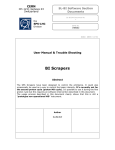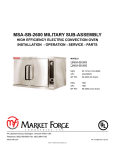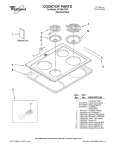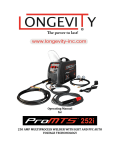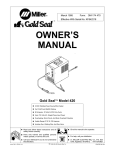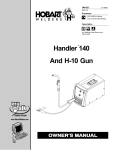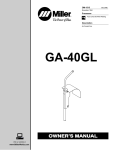Download Air Liquide A 250 AC/DC: ALW-M110500426 Owner`s manual
Transcript
A 225 AC/DC - A 250 AC/DC OWNER’S MANUAL KEEP THIS MANUAL The technical specifications and the wiring diagrams contained in this owner’s manual are valid only for the model that has the part number indicated below. A 225 AC/DC: ALW-M110500425 A 250 AC/DC: ALW-M110500426 Air Liquide Welding is a trademark of L’Air Liquide S.A. 08/01 TABLE OF CONTENTS 1 SAFETY PRECAUTIONS - READ BEFORE USING 1.1 1.2 1.3 1.4 1.5 1.6 1.7 1.8 1.9 1.10 2 SPECIFICATIONS AND DESCRIPTION 2.1 2.2 2.3 2.4 2.5 3 FRONT PANEL CONTROLS . . . . . . . . . . . . . . . . . . . . . . . . . . . . . . . . . . . . . . . . . . . . . . . .10 INSTALLATION 4.1 4.2 4.3 4.4 4.5 4.6 5 DESCRIPTION . . . . . . . . . . . . . . . . . . . . . . . . . . . . . . . . . . . . . . . . . . . . . . . . . . . . . . . . . . .7 SPECIFICATIONS . . . . . . . . . . . . . . . . . . . . . . . . . . . . . . . . . . . . . . . . . . . . . . . . . . . . . . . .7 COMES COMPLETE WITH . . . . . . . . . . . . . . . . . . . . . . . . . . . . . . . . . . . . . . . . . . . . . . . . .7 DUTY CYCLE AND OVERHEATING . . . . . . . . . . . . . . . . . . . . . . . . . . . . . . . . . . . . . . . . . . .8 VOLT-AMPERE CURVES . . . . . . . . . . . . . . . . . . . . . . . . . . . . . . . . . . . . . . . . . . . . . . . . . . .9 OPERATION 3.1 4 INSTALLATION OF EQUIPMENT . . . . . . . . . . . . . . . . . . . . . . . . . . . . . . . . . . . . . . . . . . . .3 PERSONAL PROTECTION . . . . . . . . . . . . . . . . . . . . . . . . . . . . . . . . . . . . . . . . . . . . . . . . .3 FIRE AND EXPLOSION PREVENTION . . . . . . . . . . . . . . . . . . . . . . . . . . . . . . . . . . . . . . . .4 METAL FUME HAZARDS . . . . . . . . . . . . . . . . . . . . . . . . . . . . . . . . . . . . . . . . . . . . . . . . . .4 TRANSPORTING THE POWER SOURCE . . . . . . . . . . . . . . . . . . . . . . . . . . . . . . . . . . . . . .5 MAGNETIC FIELDS CAN AFFECT PACEMAKERS . . . . . . . . . . . . . . . . . . . . . . . . . . . . . . .5 H.F. RADIATION CAN CAUSE INJURY . . . . . . . . . . . . . . . . . . . . . . . . . . . . . . . . . . . . . . . . .5 ARC WELDING CAN CAUSE INTERFERENCE . . . . . . . . . . . . . . . . . . . . . . . . . . . . . . . . . .5 WELDING AND THE EFFECTS OF LOW FREQUENCY AND MAGNETIC FIELDS . . . . . . .5 PRINCIPAL SAFETY STANDARDS . . . . . . . . . . . . . . . . . . . . . . . . . . . . . . . . . . . . . . . . . . .6 CONNECTING THE EQUIPMENT TO THE MAIN SUPPLY . . . . . . . . . . . . . . . . . . . . . . . .11 SELECTING A LOCATION . . . . . . . . . . . . . . . . . . . . . . . . . . . . . . . . . . . . . . . . . . . . . . . . .11 CONNECTION AND PREPARATION OF EQUIPMENT FOR STICK-ELECTRODE WELDING . . . . . . . . . . . . . . . . . . . . . . . . . . . . . . . . . . . . . . . . . . . . . . . . . . . . . . . . . . . . .11 WELDING PARAMETERS . . . . . . . . . . . . . . . . . . . . . . . . . . . . . . . . . . . . . . . . . . . . . . . . .12 INTERNAL CONNECTION FOR OPERATING 230, 460 OR 575 VOLTS . . . . . . . . . . . . . . .13 HOW TO INSTALL THE WHEELS . . . . . . . . . . . . . . . . . . . . . . . . . . . . . . . . . . . . . . . . . . . .13 MAINTENANCE AND TROUBLESHOOTING 5.1 5.2 ROUTINE MAINTENANCE . . . . . . . . . . . . . . . . . . . . . . . . . . . . . . . . . . . . . . . . . . . . . . . . .14 TROUBLESHOOTING . . . . . . . . . . . . . . . . . . . . . . . . . . . . . . . . . . . . . . . . . . . . . . . . . . . .14 6 A 225 AC/DC ELECTRICAL DIAGRAM . . . . . . . . . . . . . . . . . . . . . . . . . . . . . . . . . . . . . .15 7 A 250 AC/DC ELECTRICAL DIAGRAM . . . . . . . . . . . . . . . . . . . . . . . . . . . . . . . . . . . . . .16 8 A 225 AC/DC SPARE PARTS LIST . . . . . . . . . . . . . . . . . . . . . . . . . . . . . . . . . . . . . . . . . .17 9 A 250 AC/DC SPARE PARTS LIST . . . . . . . . . . . . . . . . . . . . . . . . . . . . . . . . . . . . . . . . . .18 WARNING Read and understand this entire Owner’s Manual before installing, operating or servicing this equipment. While the information contained in this Owner’s manual represents our best judgment, Air Liquide assumes no liability for its use. Reproduction of this work, in whole or part, without written permission of the publisher is prohibited. All rights reserved. The publisher does not assume and hereby disclaims any liability to any party for any loss or damage caused by any error or omission in the Air Liquide A 225 AC/DC – A 250 AC/DC Owner’s Manual, whether such error results from negligence, accident or any other causes. 1. SAFETY PRECAUTIONS - READ BEFORE USING 9 Avoid direct contact between wet garments and metal parts that are electrically charged. The use of welding equipment can cause injury to the operator. The reading and understanding of the safety standards mentioned below is compulsory prior to connecting, preparing, using or transporting welding equipment. 10. Always wear gloves and rubber-soled shoes when working in wet areas or standing on metal surfaces. 1.1 INSTALLATION OF EQUIPMENT 11. Always turn off welding equipment that is not being used. Do not leave welding equipment unattended. 1. Installation and maintenance of equipment must be performed in compliance with local safety standards. 2. Significant DC voltage exists after the removal of input power to inverters. Always discharge input capacitors before touching any parts. Service work should be completed by qualified personnel only. Frequently inspect the welder plug, receptacle and wiring. If damaged, replace immediately with approved electrical connections and adequately sized wiring. 1.2 PERSONAL PROTECTION 3. Connect the welding ground as near as possible to the operating area. 1. Welding operations produce radiation, noise, heat and noxious fumes. Suitable safety precautions must be taken to minimize the risk. 4. Do not pass welding equipment cables through or near lifting chains, crane cables or any electrical lines. 2. 5. If earth grounding of the workpiece is required, ground it directly with a separate cable. 6. Do not touch the electrode if you are in contact with the work, ground or another electrode from a different welding machine. 3. 7. Use only well-maintained equipment. Repair or replace damaged parts immediately. Maintain welding equipment according to owner’s manual. Wear fire resistant work gloves, long sleeve shirts, pants, safety shoes, cap and welding helmet to protect the skin from radiation and metal sparks. Always wear ear protection. 4. Always wear eye protection with side shields. 5. Position a fire resistant screen around the welding area to protect bystanders from radiation, sparks and slag. 8. Never use welding equipment near water. Do not spray water or other liquids on the welding equipment. 3 6. 5. In the event that a welding operation occurs in a confined place, the operator should be accompanied by another person. Compressed gas cylinders are potentially dangerous. Consult the supplier for correct handling procedures. Always protect compressed gas cylinders from the sun’s rays, flames and sudden temperature changes. 6. Always keep gas cylinders in a well-ventilated area. Close the main gas valve when cylinder is not in use. 7. Do not perform welding operations near chlorinated hydrocarbon vapors produced by degreasing or painting. The heat generated by arc rays can react to form phosgene, a highly toxic gas. 1.3 FIRE AND EXPLOSION PREVENTION Hot slag and sparks can cause fire. The risk of fire and explosion can be minimized by removing all flammable material from the welding area. 8. Irritation of the eyes, nose and throat are symptoms of inadequate ventilation. Take immediate steps to improve ventilation. Do not continue welding if symptoms persist. 1. Always perform welding operation with caution. Containers and tubes that have been emptied and thoroughly cleaned still represent a potential hazard. 1.5 TRANSPORTING THE POWER SOURCE 2. Never perform welding operations or cut a closed container or pipe. 1. The welding machine may be carried by the handle. 3. Never perform welding operations on open containers or pipes that may have been contaminated with substances that could explode or react when exposed to heat or humidity. 2. Always disconnect the power source and accessories from the main supply before lifting or handling the welding equipment. 3. Do not drag, pull or lift welding equipment by the weld cables. 4. As a preventative measure, keep fire extinguishers near the welding operation. 1.6 MAGNETIC FIELDS CAN AFFECT PACEMAKERS 1.4 METAL FUME HAZARDS Welding fumes and gases may be hazardous if inhaled. 1. 1. Install a ventilation system in the welding area. 2. Pacemaker wearers should consult with a physician prior to being exposed to any welding or cutting operation. 2. Use a forced air system when welding lead, beryllium, cadmium, zinc, zinc-coated or painted material. Always wear a protective mask. 3. If the ventilation system is inadequate, use an air respirator. 4. Beware of gas leaks. Shielding gases such as argon are heavier than air and when used in small spaces, will replace the air. 4 Keep pacemaker wearers away from welding operations. 1.9 WELDING AND THE EFFECTS OF LOW FREQUENCY AND MAGNETIC FIELDS 1.7 H.F. RADIATION CAN CAUSE INJURY 1. As welding current flows through welding cables, it can cause electromagnetic fields. To reduce magnetic fields, use the following procedures: High frequency (HF) emissions can interfere with radio navigation, safety devices, computers and communication equipment. 1 Keep cables close together by twisting or taping them. 2. Installation of welding equipment should be performed by a qualified electrician. 2. Arrange cables to one side and away from the operator. 3. The operator is responsible for having a qualified electrician correct any interference problem resulting from the welding equipment installation. 3. Do not coil or drape coils around operators body. 4. If notified by the FCC about interference, stop using the welding equipment immediately. 4. Keep welding power source and cables as far away from the operator as practically possible. 5. Have the welding equipment installation checked and maintained on a regular basis. 5. Connect work clamp to workpiece as close to the weld as possible. 6. Keep high-frequency source doors and panels tightly shut. Keep spark gaps at the correct setting and use grounding to minimize the possibility of interference. 1.8 ARC WELDING INTERFERENCE 1. CAN 1.10 PRINCIPAL SAFETY STANDARDS Safety in Welding and Cutting, ANSI Standard Z49.1 from the American Welding Society, 550 N.W. Lejeune Rd., Miami, FL 33126. CAUSE Safety and Health Standards, OSHA 29 CFR 1910, from the Superintendent of Documents, U.S. Government Printing Office, Washington, D.C. 20402. Electromagnetic energy can interfere with sensitive electronic equipment such as computers and computer-driven equipment like robots. 2. Be sure that all equipment in the welding area is electro-magnetically compatible. Recommended Safe Practices for the Preparation for Welding and Cutting of Containers That Have Held Hazardous Substances, American Welding Society Standard AWS F4.1, from the American Welding Society, 550 N.W. Lejeune Rd., Miami, FL 33126. 3. To reduce possible interference, keep weld cables as short as possible, close together and down low. National Electrical Code, NFPA Standard 70, from the National Fire Protection Association, Batterymarch Park, Quincy, MA 02269. 4. Locate welding operations at least 100 meters (350 feet) away from any sensitive electronic equipment. Safe Handling of Compressed Gases in Cylinders, CGA Pamphlet P-1, from the Compressed Gas Association, 1235 Jefferson Davis Highway, Suite 501, Arlington, VA 22202. 5. Be sure welding equipment is installed and grounded according to this manual. Code for Safety in Welding and Cutting, CSA Standard W117.2, from the Canadian Standards Association, Standard Sales, 178 Rexdale Boulevard, Rexdale, Ontario M9W 1R3. 6. If interference still occurs, the operator must take extra measures such as moving the welding machine, using shielded cables, using line filters, or shielding the work area. Safe Practices For Occupation And Educational Eye And Face Protection, ANSI Standards Z87.1 from the American National Standards Institute, 1430 Broadway, New York, NY 10018. Cutting And Welding Processes, NFPA Standards 51B, from the National Fire Protection Association, Batterymarch Park, Quincy, MA 02269. 5 EQUIPMENT INSTALLATION AND MAINTENANCE MUST BE PERFORMED IN COMPLIANCE WITH LOCAL SAFETY STANDARDS. Electric shock could be fatal 1. Never touch exposed electrical parts. 2. Switch off and disconnect the power source before installing or opening. Fumes and gases may represent a safety hazard. Fumes and gases generated during welding may be dangerous if inhaled over a long period of time. Use a protective mask with suitable glass filter (at least NR10) to safeguard eyes. 1. Keep clear of fumes. 2. Protect face, ears and neck during welding operations. Advise other persons in the vicinity to look away and stand clear of arc rays and hot metal. 3. Installation may be performed by qualified persons only. 2. Ventilate welding area or wear a breathing mask. 4. Installation procedure must comply with national electricity standards and all other relevant regulations. 3. Install a natural or forced air ventilation system in the work area. Moving parts may cause injury. Hot areas may cause injury. 1. Keep clear of hazardous areas, such as moving rollers. 1. Beware of weld flame. Always keep a fire extinguisher close at hand. 2. Never place welding equipment on inflammable surfaces. 3. Do not weld in closed containers. Welding wire may cause injury. Let the power source or other parts cool before performing any maintenance or servicing. Do not point the torch toward any part of the body, other persons or any type of metal when unwinding welding wire. A falling power source or other equipment may cause serious injury to persons or damage to objects. The positioning of welding equipment on inflammable surfaces could lead to fire outbreak or explosion. 1. Always make use of the handle to lift power source (applies to portable models). 1. Never position equipment on combustible or inflammable surfaces. 2. Use eye bolts and adequate lifting equipment to raise the power source. 2. Do not install equipment in the vicinity of inflammable liquids. 2. Keep all doors, panels and covers closed and in place. WELDING MAY CAUSE FIRES OR EXPLOSIONS. Never weld near inflammable materials. 1. Wear appropriate eye, ear and body protection equipment. 4. Let welding equipment and material cool before handling them. • INSTALLATION AND MAINTENANCE OPERATIONS MUST BE PERFORMED BY QUALIFIED PERSONS ONLY. • BEFORE INSTALLING the power source, check that the power socket satisfies ampere and voltage requirements (see data table plate). ENSURE that the socket is protected by appropriate fuses and automatic switches. • CONNECT an approved standard plug corresponding to the system socket to the power supply cable. 6 2. SPECIFICATIONS AND DESCRIPTION 2.1 DESCRIPTION The 225 AC/DC sets a new standard for economical AC/DC arc welding machines. This ruggedlybuilt welder is a proven performer with serious amperage to burn 2.5 mm (3/32 in) to 4.0 mm (5/32 in) low-hydrogen and special-alloy electrodes. A standard running gear improves mobility and assists the operator in positioning the equipment for those hard-to-reach areas. Standard dinse connections increase the versatily of the equipment and make welding cable replacement an easy task. The 230/460 volt, 1-phase input power gives operators the option of choosing the power connections that are right for them. Infinte current regulation allows precise setting of amperage to achieve the exact heat for your welding needs. The 250 AC/DC sets a new standard for AC/DC arc welding machines. This ruggedly-built welder is a proven performer with serious amperage to burn 2.5 mm (3/32 in) to 4.0 mm (5/32 in) low-hydrogen and special-alloy electrodes. A standard running gear improves mobility and assists the operator in positioning the equipment for those hard-to-reach areas. Standard dinse connections increase the versatily of the equipment and make welding cable replacement an easy task. The 230/460/575 volt, 1-phase input power gives operators the option of choosing the power connections that are right for them. Infinite current regulation allows precise setting of amperage to achieve the exact heat for your welding needs. 2.2 SPECIFICATIONS A 225 AC/DC A 250 AC/DC 2.3 COMES COMPLETE WITH: A 225 AC/DC A 250 AC/DC 1. 2.4 m (8 ft) input power cord without plug 2. Handle and running gear 1. Handle and running gear For options and accessories contact your distributor. 7 2.4 DUTY CYCLE AND OVERHEATING: Duty cycle is the percentage of 10 minutes that the unit can weld at its rated output without overheating. If the unit overheats, the weld output will stop. To correct this situation, wait fifteen minutes for the unit to cool. Reduce amperage or duty cycle before starting to weld again. A 225 AC/DC DUTY CYCLE OUTPUT AMPERES OUTPUT AMPERES A 225 AC/DC 250 AC 200 150 100 DC 50 0 10 20 30 40 50 60 70 80 90 100 90 100 % DUTY CYCLE A 250 AC/DC DUTY CYCLE OUTPUT AMPERES OUTPUT AMPERES A 250 AC/DC 300 250 AC 200 150 100 DC 50 0 10 20 30 40 50 60 % DUTY CYCLE 8 70 80 2.5 VOLT-AMPERE CURVES Volt-ampere curves show the maximum voltage and amperage output capabilities of the welding power source. Curves of other settings fall under curves shown. A 225 A225 AC/DC AC/DC 90 80 MAX DC 70 MAX AC Voltage (V) Tensione (V) 60 50 MIN AC 40 30 20 MIN DC 10 0 0 20 40 60 80 100 120 140 160 180 200 220 240 260 280 300 200 220 240 260 280 300 Corrente (A) Amperage (A) A 250 AC/DC A250 AC/DC 90 80 70 MAX AC Voltage (V) Tensione (V) 60 50 MAX DC MIN AC 40 30 20 MIN DC 10 0 0 20 40 60 80 100 120 140 160 Corrente (A) (A) Amperage 9 180 3. OPERATION 3.1 FRONT PANEL CONTROLS 4 6 1 5 3 9 2 7 4 8 6 1 5 3 9 2 7 8 1. AMPERAGE ADJUSTMENT CONTROL 5/6. AC WELD OUTPUT RECEPTACLE 2. POWER-ON LIGHT 7. POSITIVE WELD OUTPUT RECEPTACLE 3. POWER SWITCH 8. NEGATIVE WELD OUTPUT RECEPTACLE 4. AMPERAGE INDICATOR 9. DATA PLATE 10 4. INSTALLATION 4. Avoid areas where dust or other objects could be sucked into the system. Before connecting, preparing or using equipment, read Section 1: Safety Precautions. 5. Equipment must not obstruct corridors or work activities of other personnel. 7. Position the power source securely to avoid falling or overturning. 4.1 CONNECTING THE EQUIPMENT TO THE MAIN SUPPLY 8. Understand the risk of falling equipment situated in overhead positions. The equipment is shipped without an installed plug. For the A 225 AC/DC, use a plug that is suitable for carrying the amps indicated on the data plate. 4.3 CONNECTION AND PREPARATION OF EQUIPMENT FOR STICK-ELECTRODE WELDING. For the A 250 AC/DC, install a #8 or larger input power cord to the internal connections indicated in section 4.5. Use a plug that is suitable for carrying the amps indicated on the data plate. Connect all welding accessories carefully to prevent power loss. Carefully follow safety precautions described in section 1. Check to ensure that the power outlet is equipped with a fuse that is capable of carrying the amps indicated on the data plate of this unit. TURN OFF WELDER BEFORE MAKING CONNECTIONS. DC MODE 4.2 SELECTING A LOCATION 1. Connect the ground cable to the negative receptacle and locate the ground clamp near the welding zone. Special installation may be required where gasoline or volatile liquids are present (See NEC Article 511 or CEC Section 20). Do not move or operate this equipment where it could tip over. When selecting a location for this equipment, ensure that the following guidelines are followed. 2. Connect the electrode cable to the positive receptacle and fit the selected welding electrode into the electrode holder. 3. Use the above connection for welding electrodes that use DCEP (Reverse Polarity) welding current. Reverse the connection for welding electrodes that use DCEN (Straight Polarity) welding current. 1. Use data plate to determine input power requirements. 2. The operator must have unobstructed access to all controls and equipment connections. AC MODE 3. Do not position equipment in small, closed places. Ventilation of the power source is extremely important. Make sure that the louvers on the side panels are not obstructed and that there is no risk of obstruction during operation. 1. Connect the ground cable and the electrode cable to the AC receptacles. 2. Fit the selected welding electrode into the electrode holder. 11 4.4 WELDING PARAMETERS 12 4.5 INTERNAL CONNECTION FOR INSTALLING 230, 460 OR 575 VOLTS TURN OFF WELDER BEFORE MAKING CONNECTIONS. A 250 AC/DC 230 V 460 V 230 V 4.6 HOW TO INSTALL THE WHEELS 13 460 V 575 V L1 L2 GND G 1 2 3 4 5 6 7 8 9 L1 L2 GND G 1 2 3 4 5 6 7 8 9 L1 L2 GND G 1 2 3 4 5 6 7 8 9 GND G 1 2 3 4 5 GND G 1 2 3 4 5 G 1 2 3 4 5 G 1 2 3 4 5 6 7 8 9 A 225 AC/DC 5. MAINTENANCE AND TROUBLESHOOTING Disconnect power before maintenance. Service more often during severe conditions. 5.1 ROUTINE MAINTENANCE Every three (3) months, perform the operations below: 1. Replace unreadable labels 2. Clean and tighten weld terminal connections 3. Repair or replace worn hoses and cables 4. With dry compressed air, blow out the unit to reduce the build-up of dust. Every six (6) months perform the operations below: Blow out the inside of the unit Increase frequency of cleaning when operating in dirty or dusty conditions. 5.2 TROUBLESHOOTING 14 6. A 225 AC/DC ELECTRICAL DIAGRAM A 225 AC/DC 15 7. A 250 AC/DC ELECTRICAL DIAGRAM A 250 AC/DC 16 8. A 225 AC/DC SPARE PARTS LIST 17 18 9. A 250 AC/DC SPARE PARTS LIST 19 20





















